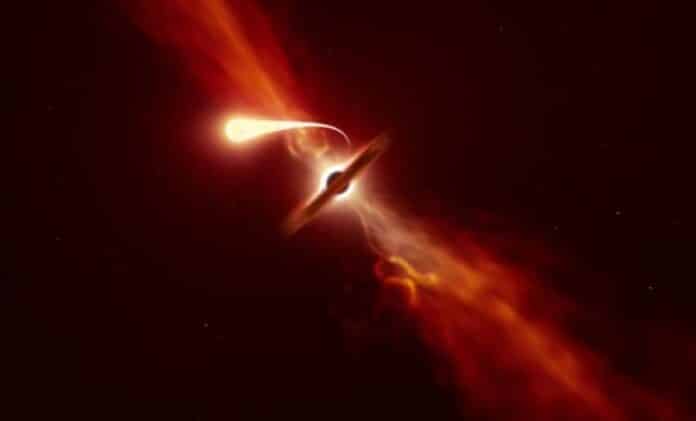The astrophysical phenomenon J221951-484240, commonly known as J221951, is one of the brightest transients (astrophysical objects whose brightness changes over a brief period) ever observed.
J221951 was discovered in September 2019 while looking for electromagnetic light from a gravitational wave event. The Neil Gehrels Swift Observatory’s Ultra-Violet and Optical Telescope was used to search for a kilonova, which results from a neutron star merging with another neutron star or a black hole. They did, however, discover J221951, which appeared blue but did not change color or fade as quickly as a kilonova would.
One of the most dramatic “switches on” of a black hole ever seen has been found by a team of astronomers from Queen’s University Belfast, University College London, and the University of Birmingham.
NASA’s Swift/UVOT and Hubble Space Telescopes, the South African Large Telescope, and ESO facilities such as the Very Large Telescope and the GROND instrument on the MPG/ESO 2.2-meter telescope at the La Silla Observatory were utilized to track J221951.
A Hubble Space Telescope spectrum of J221951 ruled out any relationship with the gravitational wave event. Dr. Oates and her colleagues determined that the source of J221951 is around 10 billion light years away by analyzing its light spectra, as opposed to the gravitational wave signal, which was found less than 0.5 billion light years away.
According to research, J221951 was created due to a supermassive black hole quickly devouring its surroundings. The location of J221951 is congruent with the galaxy’s center, where a huge black hole would naturally reside; a red galaxy was detected at the site before it was discovered. It began to shine around ten months before the first detection, indicating that the black hole had been silent until it suddenly began to feed.
This is one of the most spectacular “switches on” of a black hole ever observed since the ultraviolet spectrum exhibits absorption patterns associated with material pushed outwards by a massive release of energy.
The team has determined two potential explanations for the extreme feeding of a supermassive black hole: the first is produced by a tidal disruption event, in which a star is destroyed as it passes by the supermassive black hole at the center of its galaxy, or the second is caused by an active galactic nucleus’ changing state’ from dormant to active. J221951 would then be the evidence that an accretion disc has started to feed on material from a dormant black hole at the center of the host galaxy.
Dr. Matt Nicholl, a member of the team from Queen’s University Belfast, said, “Our understanding of the different things that supermassive black holes can do has greatly expanded in recent years, with discoveries of stars being torn apart and accreting black holes with hugely variable luminosities.”
He adds, “J221951 is one of the most extreme examples of a black hole taking us by surprise. Continued monitoring of J221951 to work out the total energy release might allow us to determine whether this is a tidal disruption of a star by a fast-spinning black hole or a new kind of AGN switch on”.
The significant discovery came when Hubble’s ultraviolet spectrum ruled out a Galactic origin, demonstrating the need to keep a space-based UV spectrograph capacity in the future.
Dr. Samantha Oates adds, “In the future, we will be able to obtain important clues that help distinguish between the tidal disruption event and active galactic nuclei scenarios. For instance, if J221951 is associated with an AGN turning on, we may expect it to stop fading and to increase again in brightness, while if J221951 is a tidal disruption event, we would expect it to continue to fade. We will need to continue to monitor J221951 over the next few months to years to capture its late-time behavior.”
They will present their findings on Tuesday 4 July at the 2023 National Astronomy Meeting in Cardiff. The work will also be published in Monthly Notices of the Royal Astronomical Society.
